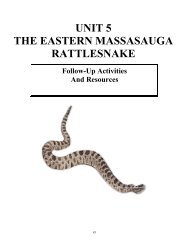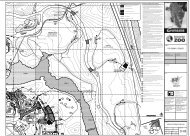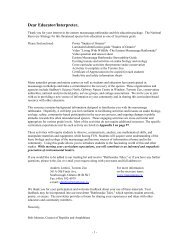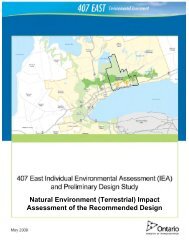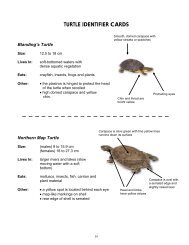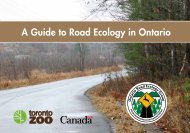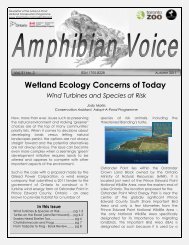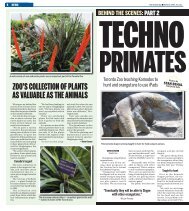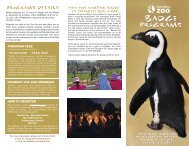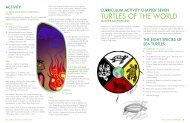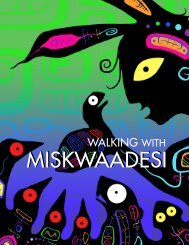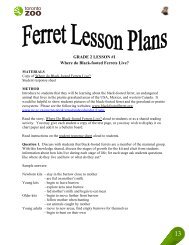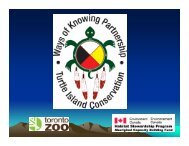Turtle Identification - Toronto Zoo
Turtle Identification - Toronto Zoo
Turtle Identification - Toronto Zoo
Create successful ePaper yourself
Turn your PDF publications into a flip-book with our unique Google optimized e-Paper software.
ACTIVITY #2:<br />
TURTLE IDENTIFICATION: Answer Sheet<br />
Distribution in<br />
Canada<br />
Habitat<br />
Description<br />
Feeding<br />
Status<br />
Conservation<br />
Concerns<br />
Interesting<br />
Facts<br />
Blanding’s turtle Northern map turtle Common musk turtle<br />
aka: Stinkpot<br />
-southern Ontario -Great Lakes/St.<br />
-southern Ontario<br />
-western Quebec Lawrence watershed -Quebec, near the<br />
-Nova Scotia<br />
-southern Ontario Ottawa River<br />
-Quebec<br />
-highly productive<br />
water<br />
-soft-bottomed<br />
-dense aquatic<br />
vegetation<br />
-12.5-18 cm<br />
-carapace: smooth,<br />
domed, black to greybrown<br />
with yellow<br />
streaks/spots<br />
-plastron: black or<br />
yellow with dark<br />
blotches, hinged<br />
-chin & throat are<br />
yellow<br />
-bulging eyes<br />
-omnivorous<br />
-crayfish, insects,<br />
fish, frogs, plants<br />
-Ontario population<br />
not designated at risk<br />
in Ontario or by<br />
COSEWIC<br />
-Nova Scotia<br />
population designated<br />
as threatened by<br />
COSEWIC in 1993<br />
-abandons nesting &<br />
basking sites if<br />
disturbed<br />
-traffic mortalities<br />
-high nest predation<br />
-loss of wetland<br />
habitat<br />
-camouflaged<br />
carapace looks like<br />
duckweed<br />
-can live to 25 years,<br />
some say 70<br />
-hibernates<br />
underwater in mud<br />
-larger rivers & lakes<br />
-slow-moving, high<br />
quality water<br />
-soft-bottomed<br />
-males: 9-15.9 cm<br />
-females: 18-27.3 cm<br />
-carapace: oval with<br />
serrated back edge,<br />
slightly raised keel, olive<br />
green with yellow lines<br />
resembling map<br />
-plastron: yellow<br />
-head & limbs light yellow<br />
& dark stripes<br />
-yellow spot behind each<br />
eye<br />
-molluscs, insects, fish<br />
carrion, plant material<br />
-not designated at risk<br />
provincially in Ontario<br />
-designated as a species<br />
of special concern by<br />
COSEWIC in 2002<br />
-shoreline development<br />
destroys nesting habitats<br />
-vulnerable to water<br />
pollution (dependent on<br />
molluscs)<br />
-traffic mortalities<br />
-females begin eating<br />
after eggs are laid<br />
(usually July)<br />
-home range size greater<br />
for females than males<br />
-adults hibernate & bask<br />
communally<br />
-basking important for<br />
development of eggs in<br />
females<br />
-rivers, lakes & ponds<br />
-slow moving water<br />
-soft-bottomed<br />
-shallow areas<br />
-5.1-11.5 cm<br />
-carapace: domed,<br />
smooth, light olive to<br />
black in colour<br />
-plastron: small, yellowbrown,<br />
single hinge<br />
-single stripe above &<br />
below eye on both sides<br />
of head<br />
-chin & throat covered in<br />
barbels<br />
-omnivorous, often<br />
scavenging<br />
-bottom feeders<br />
-algae, carrion, small<br />
invertebrates, fish eggs,<br />
minnows, tadpoles<br />
-not designated at risk<br />
provincially in Ontario<br />
-designated as a<br />
threatened species by<br />
COSEWIC in 2002<br />
-occasionally caught by<br />
anglers using minnows or<br />
worms on hooks<br />
-habitat loss &<br />
fragmentation<br />
-nicknamed Stinkpot<br />
because of musky odour<br />
produced when handled<br />
-nocturnal<br />
-rarely leaves water<br />
-may climb trees or<br />
branches overhanging<br />
water<br />
-very aggressive<br />
-Ontario’s smallest turtle<br />
Common snapping<br />
turtle<br />
-occurs from Maritimes to<br />
southern Saskatchewan<br />
-parts of southern Alberta &<br />
New Brunswick<br />
-shallow ponds, rivers,<br />
streams, canals & lakes<br />
-slow-moving water<br />
-soft-bottomed<br />
-plenty of vegetation<br />
-20.3-36 cm<br />
-carapace: light brown to<br />
black, young turtles have<br />
raised keels<br />
-plastron: yellowish, very<br />
small & cross-shaped<br />
-two barbels on chin, neck is<br />
covered with rounded<br />
tubercles<br />
-serrated tail dinosaur-like,<br />
same length as carapace<br />
-omnivorous, often<br />
scavenging<br />
-fish, invertebrates, plants,<br />
toads, frogs salamanders,<br />
tadpoles, small turtles,<br />
snakes, young waterfowl,<br />
small mammals, carrion<br />
-not designated as a species<br />
at risk provincially in Ontario<br />
or by COSEWIC<br />
-traffic mortalities<br />
-sometimes considered<br />
human food delicacy<br />
-persecuted due to<br />
misinformation on its<br />
perceived threat to people, &<br />
game animals<br />
-rarely leave water<br />
-aggressive on land because<br />
of vulnerability due to small<br />
plastron<br />
-releases foul-smelling liquid<br />
from glands under carapace<br />
-world’s largest snapping<br />
turtle (32 kg) was once<br />
housed at <strong>Toronto</strong> <strong>Zoo</strong>.<br />
35



